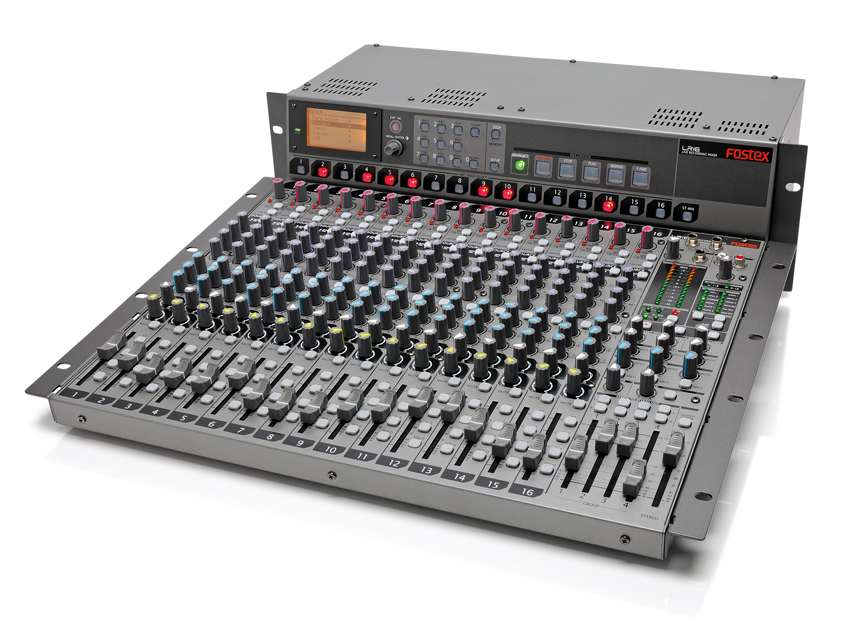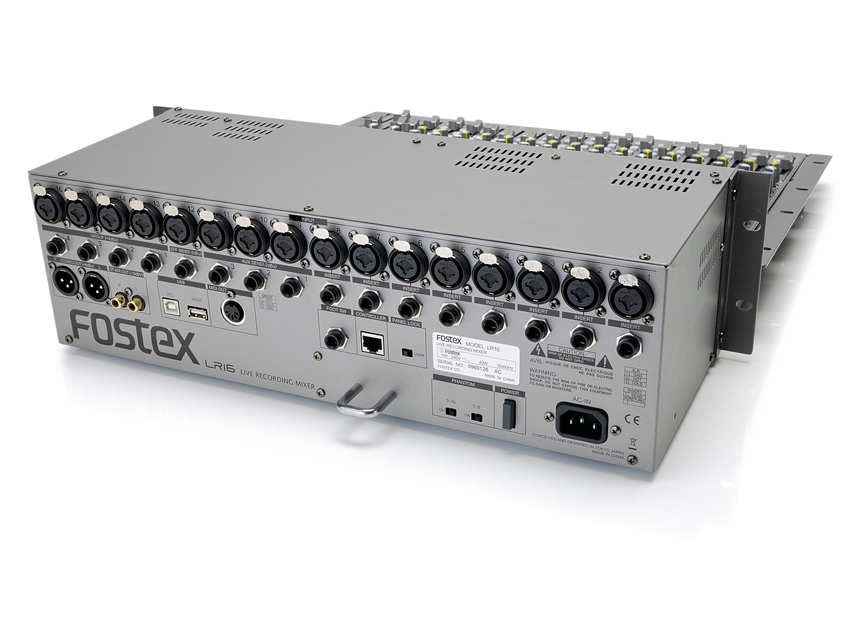MusicRadar Verdict
A workhorse of a live gig recorder. It does exactly what it's supposed to and it does it perfectly.
Pros
- +
Ruggedly built. Recorder and mixer can be located up to 50m apart. Dead easy one-touch recording.
Cons
- -
Doesn't offer as many features as some of the competition.
MusicRadar's got your back

Fostex LR16

Fostex LR16
There's been a proliferation lately of portable handheld digital stereo recorders that are ideal for recording live gigs and rehearsals (assuming that you want to capture the sound in stereo as it is heard in the room).
But what if you want to capture the band as a multitrack recording for mixing at a later date, with the individual elements of the drum kit and all of the instruments recorded to separate tracks?
Rather than messing about with connecting up the various permutations of separate mixers, hardware recorders, audio interfaces and computers, is there one single practical and portable item of equipment that can do the job?
Fostex seems to think it has the answer with the LR16, which combines a 16-track digital recorder with a 16-channel mixer. Now, while that may sound just like the description of an all-in-one 'portastudio' style unit, there's a difference here - the LR16 has separate mixer and recorder sections that are connected via a CAT5 Ethernet cable and can therefore be quite some distance (up to 50m) apart.
This gives you plenty of flexibility in regard to positioning, possibly removing the need for stage boxes and multicore cabling.
In detail
No audio signal is carried on the CAT5 cable - the mixer section is purely for sending control data to the recorder and is equipped with record, stop and play controls. All the crucial audio connections are on the rear of the recorder, allowing convenient positioning on a stage close to microphones and, quite likely, the amps and speakers of a PA system while the mixer, in a convenient location, can take care of the live front-of-house and monitor mixes as well as the recorder.

With a rugged metal chassis, the LR16 is designed for heavy-duty work and Fostex has done a great job in getting all the controls into a 19-inch rackmount without anything feeling squashed.
Both the Control Unit (mixer section) and Main Unit (recorder section) of the LR16 have removable rack ears and can be fixed together in two different configurations if not set apart.
Three aux sends per channel (one pre-fade, one post-fade and one that is switchable between pre and post) take care of sending the signal for foldback or to any external effects processors. The LR16 is equipped with an onboard effects processor with a selection of reverb and delay effects and these are accessed from each channel by a rotary knob above the channel pan control.
Solo and Mute switches complete the channel along with routing buttons to the stereo mix and groups 1-2 and 3-4.
The recorder has a built-in 80GB HD for approximately 16 hours of 16-track uncompressed digital recording at 16-bit/44.1kHz or nine hours at 24-bit/48kHz. Both a multitrack and a stereo mix can be recorded simultaneously.
The audio for the 16 individual tracks is taken directly after the input gain stage (and insert) while the stereo audio is a mix created using the EQ, effects, channel faders and pan pots - basically the front-of-house live mix that would be outputted to the PA to the delighted crowd.
In Use
If directly compared to the hardware studio-in-a-box competition (with their rhythm tracks, multi-FX and audio editing functions) the LR16 could be seen to be pretty spartanly equipped, but this is missing the point.
It's not designed to painstakingly build up a production one track at a time, but to record up to 16 tracks of audio simultaneously while at the same time providing, if desired, monitor mixes and a stereo mix for live sound. A streamlined no-nonsense approach is what is required and that's what you get.
Initiating a recording is pretty straightforward. Once the tracks have been armed, a single hit of the record button gets things going with a new 'Project' being created each time recording is initiated.
A new folder is created on the hard drive for each new project. In the folder the audio is stored as WAV files - 16 mono WAV files for the 16 individual recorded tracks plus a single stereo file for the simultaneous live stereo mix. If the mixer is used at a later stage to mix down the 16 individual tracks to create a new stereo mix then that is saved as another stereo file.
As the LR16 has no real audio editing capabilities it is perhaps most likely to be used for audio capture with the intention of transferring the audio to a computer via USB for later mixing. To this end the LR16's HD is FAT32 formatted and will appear as a mounted drive on a computer desktop. The USB connection also supports backup to a USB memory stick.
Outside of the 'New Project' mode, overdubbing onto spare tracks or punch-ins on recorded ones can be carried out.
All recorded tracks can be routed back to the channels for mixdown, although transferring projects to a computer-based DAW would allow more sophisticated mixing with the use of plug-in effects.
With no dedicated effects returns - meaning an external processor can't be used if 16 input channels are needed for mics and instruments - the internal effects are quite crucial and, although basic and non-editable, they do provide ambience that works well in a live context and, along with the useful degree of EQ cut and boost, allow the tailoring of a workable live mix as your pristine audio is recorded to the hard drive.
Summary
There's no identity crisis with the LR16 - it knows exactly what its job is and it does it perfectly. It's ideal for small venues and rehearsal rooms where there's the need to record a live band or solo act, and could find its way into the kind of project studio where ensemble playing needs to be captured with a minimum of fuss.
Future Music is the number one magazine for today's producers. Packed with technique and technology we'll help you make great new music. All-access artist interviews, in-depth gear reviews, essential production tutorials and much more. Every marvellous monthly edition features reliable reviews of the latest and greatest hardware and software technology and techniques, unparalleled advice, in-depth interviews, sensational free samples and so much more to improve the experience and outcome of your music-making.
“Built from the same sacred stash of NOS silicon transistors and germanium diodes, giving it the soul – and snarl – of the original”: An octave-fuzz cult classic returns as Jam Pedals resurrects the Octaurus
What’s the buzz? Meet Yellowjacket, Cherry Audio's recreation of EDP’s trend-setting Wasp from 1978
“A fabulous trip through all eight songs by 24 wonderful artists and remixers... way beyond anything I could have hoped for”: Robert Smith announces new Cure remix album










